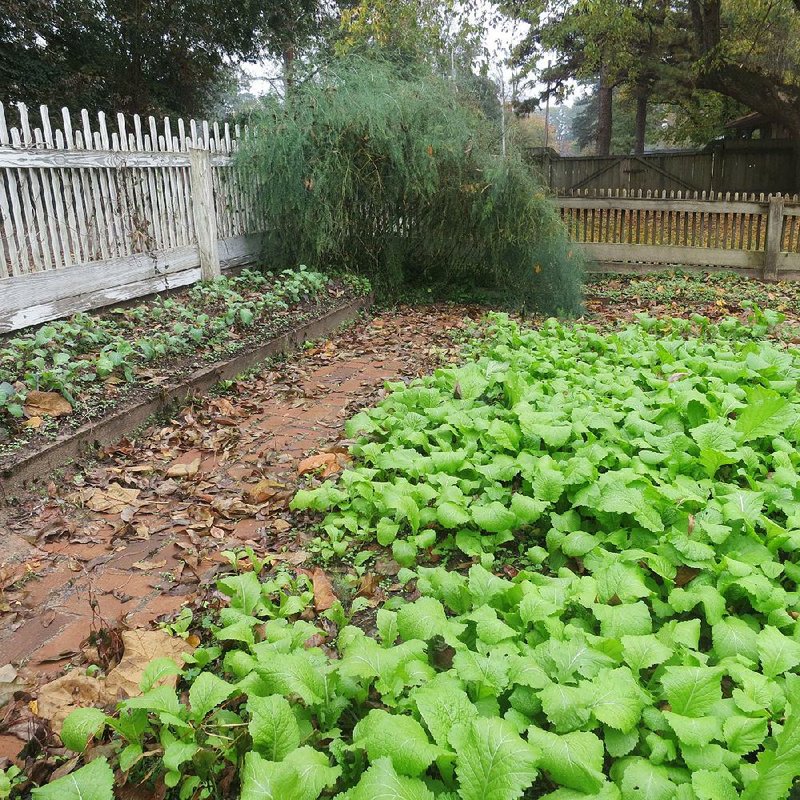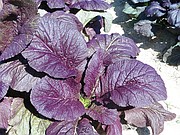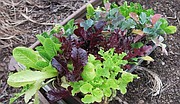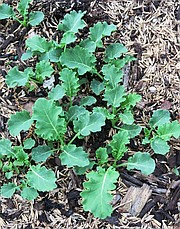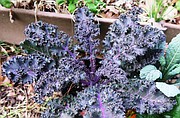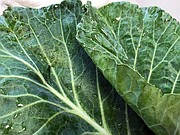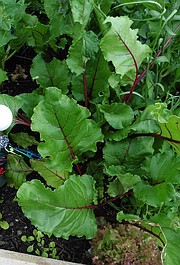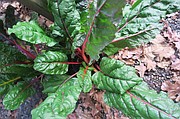Orange, red, yellow and brown are the colors of fall, but for gardeners pulling up summer plants and thinking about cool-season crops, now is a great time to plant greens.
From a staple Southern food to a hard hitter in the nutritional world, greens have gained in popularity nationwide. "Edible gardening" continues to garner more support -- and gardeners. Greens fit the concept perfectly. Planted as row crops or added to a landscape, they look good enough to eat.
The term "greens" encompasses more than just turnips and collards. It includes spinach, beets, kale and Swiss chard, and we can branch out and add lettuce and its kissing cousins to the mix as well. Whichever is your favorite, now is the time.
When you group the greens collectively, they are all basically cool-season plants. They can be planted as an early spring crop or as a fall crop, and today some gardeners are growing them year-round with just a bit of support depending on the winter extremes.
For a fall harvest, the latest they can be planted varies by where you are in the state and whether you plan to protect them from freezing temperatures. If planting from seed with no winter protection:
• In northern Arkansas, they need to be in the ground no later than mid-September.
• In central Arkansas you have until late September.
• In southern Arkansas you can even plant in early October.
With the addition of transplants of kale, Swiss chard, lettuce and spinach, we can extend the planting time. With transplants or with high tunnels or winter covering, you can continue to plant into October statewide and possibly into early November.
If left unprotected, how long they last into the winter months is largely determined by what type of weather we have and what you are growing. Kale and collards are the most cold tolerant, lettuce the least. While turnips can burn back with a heavy frost, they will usually bounce back unless the temperatures stay in the low teens or single digits.
While all prefer full sun, greens will tolerate some shade. An added benefit of shade is that deciduous trees drop their leaves in the fall and allow more light to reach the winter and early spring growth.
Fall planting has benefits and drawbacks. Warm soil temperatures often give you faster germination and growth than do the cooler soils of early spring. But typically hot, dry weather in late summer/early fall means you must pay more attention to watering. If you were lucky enough to plant before the recent rainfalls, your plants got a boost and you didn't have to monitor as closely.
Another drawback can be insect pressure, which builds all summer. Monitor your plants closely to catch any infestations before they ruin your crop.
On the plus side, harvesting in cool weather often produces better flavor in the greens.
Nutritionally, you can't beat greens. They are high in vitamin A, vitamin K, folic acid, dietary fiber, antioxidants, carotenoids, riboflavin and iron. They are a great way of making sure you get your five servings of fruits and vegetables per day.
SPINACH
While many of us aren't Popeye wannabes, popping open a can of spinach and downing it, spinach has made a comeback and is used frequently in everything from dips and quiches to pasta dishes and even bread. Raw spinach salads are popular; and it is touted as a lettuce replacement on sandwiches and hamburgers.
Spinach may not be the easiest of the greens to grow, but it can be grown in spring and fall. It needs a more alkaline soil, with a minimum pH of 6.
Spinach likes even moisture but won't tolerate wet feet. It also needs nutrition. Use a complete fertilizer at planting, and then side dress with a high-nitrogen fertilizer a month after planting. Depending on how well it is growing, apply a second side dressing two weeks later.
With fall planting, you can begin harvesting within 45 days.
There are two general types of spinach -- flat leaf and curly leaf or savoy. Flat-leaf types grow faster than the crinkled types, but both grow well here -- so plant the one you prefer.
When seeding spinach, sow seeds an inch apart. If you seed too heavily, you must thin out the seedlings for best production.
COLLARDS
Collard greens are one of the oldest members of the cabbage group. These leafy, nonheading cabbages originated in the eastern Mediterranean or Asia Minor and are the wild forms of cabbage.
Today they are being used as traditional cooked greens but also show up raw in salads and smoothies.
If you can find transplants, you can still plant them statewide, and seeds can be planted in mid- to southern Arkansas. Home gardeners often start collards from transplants instead of seeds, to speed up the harvest. When planting from seed there is a 60-day minimum wait before harvest. If you plant transplants, you can begin harvesting in 30 days.
The average home gardener picks individual leaves and so can harvest from one plant many times.
Harvest season for collards can be all winter. They will tolerate more cold weather than almost any other vegetable we grow.
Collards are slower growing than other greens, but they will tolerate a wider range of soils. Avoid soils that hold water in the winter, or your plants will rot. If your soil stays wet, consider using raised beds.
Fertilization should be done at planting, and then side dress two to three times throughout the season, depending on the weather and how they are growing. With fall planting, be on the lookout for pests. Caterpillars feast on collards, especially early in the fall. BT (Dipel or Thuricide), made from a naturally occurring bacteria found in soil, is very effective in controlling the caterpillars safely.
KALE
Of all the greens on the market, kale is the king. Grocery stores can't keep it on the shelf. Kale is one of the "super foods." There are many varieties, and it can be as ornamental as it is edible. There are green varieties, curly or smooth, red or bluish kale.
Cooked kale can be the traditional mess of greens, but kale salads, smoothies, chips and more are on restaurant menus across the country.
The plants' cultural needs are very similar to collards and kale also is quite cold tolerant. You can pick individual leaves for eating or garnishing.
Instead of ornamental kale, try planting one of the many edible varieties for edible landscaping. "Redbor," "Lacinato" (dinosaur kale), curly kale and "Red Russian" are some to try.
TURNIPS
Turnips have been grown for nearly 4,000 years and have spread all over the world from their original home in Europe. While commercial growers use different varieties for the root and the greens, home gardeners often want turnips for both purposes.
Many of the commercial varieties which are grown for greens do not produce much in the way of roots. The greens are harvested quickly, which can also reduce the size of the root. Home gardeners will thin out the plants as they grow -- eating the greens that they thin, and leaving behind others to form roots.
Turnips are a shallow-rooted cool season crop and need ample water for germination and vigorous growth. Generally speaking, a lighter soil is best for turnips, especially if you are hoping to get roots as well as greens. If you are interested in roots, back off on the nitrogen fertilizer a bit, so that you don't have as many tops.
Turnips make a nice winter cover crop. They may burn after a hard freeze but will bounce back in warmer weather. The roots and greens can be harvested all winter and spring.
MUSTARD
Mustards culturally are very similar to turnips, but have a more pungent foliage. If you are growing them both and need to tell which seedling is which, take a bite. The turnip seedling has little taste, and the mustard will burn your tongue.
A little fresh mustard thrown in with a mix of salad greens gives a nice spicy flavor.
While not marketed as an ornamental, options include several truly outstanding, colorful plants -- "Osake Purple" and "Giant Red" produce an abundance of dark purplish red leaves. They add a nice touch to edible landscaping.
BEETS
Beets grow a little too slowly in the fall to produce a root crop, but they do nicely for greens. Beets are typically not thought of as a green, only as a root crop, but their taste is fairly similar to spinach and could be used as a spinach substitute -- albeit a different color.
For those of us who balk at pickled beets, try adding some leaves in with a salad mix.
Beets are easier to grow than spinach, given the same growing conditions -- higher soil pH, adequate moisture and fertilizer.
While many think the beet foliage is always attractive with its red veins, there are some very showy varieties that can be used for ornamental purposes -- "Bulls Blood" has a dark reddish-purple leaf.
CHARD
Swiss chard is similar in culture to beets and spinach -- higher pH, plenty of moisture and soil with moderate fertility. Swiss chard was not a commonly grown vegetable in Arkansas until the "Bright Lights" variety hit the market as an ornamental. Folks started eating it.
It can be grown almost year-round. Not quite so cold tolerant as collards and kale -- chard burns back in a hard freeze -- but it takes mid- to low teens to kill it outright. Cover it on really cold days with an inverted flower pot, and it can make it through a freeze unscathed.
Swiss chard has more variability of leaf colors than other greens. The stalks, or petioles, are where the main color is, but there will also be some in the veins of the leaves. Many of the standard chards have a nice cream or white petiole, which complements the green leaves. "Rhubarb chard" has an outstanding red stalk, but the showiest is "Bright Lights" -- with a mixture of orange, yellow, reds, white and pink.
LETTUCE
Myriad lettuce varieties are available and easily grown from seed. While they are the least cold tolerant greens, they are also the fastest producers, many able to be harvested within 30 or 40 days after seeding.
While some people still love iceberg lettuce, not only does it not perform well in Arkansas, it is often considered the least nutritious of all the lettuces. Instead, try red leaf, oak leaf, butter head or arugula or a mesclun mix. But plant soon, so you have time to harvest before cold hits.
Southern greens are a versatile group of vegetables. They can be planted in spring and fall. With just a little ingenuity you can harvest from fall through spring. If you haven't given greens a try lately, you might want to reconsider.
Janet B. Carson is a horticulture specialist for the University of Arkansas Cooperative Extension Service.
HomeStyle on 09/15/2018

